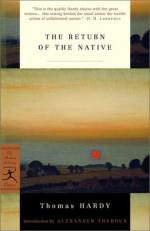The form was so much like an organic part of the entire motionless structure that to see it move would have impressed the mind as a strange phenomenon. Immobility being the chief characteristic of that whole which the person formed portion of, the discontinuance of immobility in any quarter suggested confusion.
Yet that is what happened. The figure perceptibly gave up its fixity, shifted a step or two, and turned round. As if alarmed, it descended on the right side of the barrow, with the glide of a water-drop down a bud, and then vanished. The movement had been sufficient to show more clearly the characteristics of the figure, and that it was a woman’s.
The reason of her sudden displacement now appeared. With her dropping out of sight on the right side, a new-comer, bearing a burden, protruded into the sky on the left side, ascended the tumulus, and deposited the burden on the top. A second followed, then a third, a fourth, a fifth, and ultimately the whole barrow was peopled with burdened figures.
The only intelligible meaning in this sky-backed pantomime of silhouettes was that the woman had no relation to the forms who had taken her place, was sedulously avoiding these, and had come thither for another object than theirs. The imagination of the observer clung by preference to that vanished, solitary figure, as to something more interesting, more important, more likely to have a history worth knowing than these new-comers, and unconsciously regarded them as intruders. But they remained, and established themselves; and the lonely person who hitherto had been queen of the solitude did not at present seem likely to return.
III
The Custom of the Country
Had a looker-on been posted in the immediate vicinity of the barrow, he would have learned that these persons were boys and men of the neighbouring hamlets. Each, as he ascended the barrow, had been heavily laden with furze-faggots, carried upon the shoulder by means of a long stake sharpened at each end for impaling them easily—two in front and two behind. They came from a part of the heath a quarter of a mile to the rear, where furze almost exclusively prevailed as a product.
Every individual was so involved in furze by his method of carrying the faggots that he appeared like a bush on legs till he had thrown them down. The party had marched in trail, like a travelling flock of sheep; that is to say, the strongest first, the weak and young behind.
The loads were all laid together, and a pyramid of furze thirty feet in circumference now occupied the crown of the tumulus, which was known as Rainbarrow for many miles round. Some made themselves busy with matches, and in selecting the driest tufts of furze, others in loosening the bramble bonds which held the faggots together. Others, again, while this was in progress, lifted their eyes and swept the vast expanse of country commanded by their position, now lying nearly obliterated by shade. In the valleys of the heath nothing save its own wild face was visible at any time of day; but this spot commanded a horizon enclosing a tract of far extent, and in many cases lying beyond the heath country. None of its features could be seen now, but the whole made itself felt as a vague stretch of remoteness.




